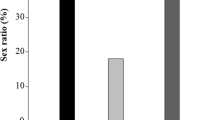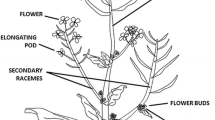Abstract
Laboratory trials were conducted in Uganda at the Kawanda Agricultural Research Institute to determine attraction, eclosion success and larval survivorship of the banana weevil Cosmopolites sordidus (Germar) on crop residues of different ages. In the first experiment, studies focused on different types and ages of residues of one susceptible highland banana clone ‘Nabusa’ (genome group AAA-EA). Corms attracted 65% of the test weevils, pseudostems 30%, while 5% were non-respondents. Oviposition levels and the number of eggs per female were higher on young than old corms. Eclosion rates of <1-day-old eggs inserted into corm pieces of residues (cultivar ‘Kisansa’, genome group AAA-EA) declined from 66% in residues collected < 2 days after harvest (DAH) to 58% in residues collected > 30 DAH. To assess immature survival, <1-day-old 1st instar larvae were put on banana corms of suckers and crop residues of the cultivar Kisansa in single rearing chambers. The number of surviving individuals was recorded at 3-day intervals until adults emerged. Survivorship was 12% on sword suckers, 10% on maiden suckers and 7% on flowered plants; and 12% on residues collected < 2 DAH and 5% on residues collected > 30 DAH. Larval duration and mean days taken for adult emergence increased with plant and crop residue age. Females emerging from the different plant and residues treatments were similar in weight. The data suggest that all aged residues are suitable hosts for C. sordidus, suggesting that sanitation practices should be implemented soon after harvest.
Similar content being viewed by others
References
Abera A. M. K. (1997) Oviposition preferences and timing of attack by the banana weevil (Cosmopolites sordidus Germar) in East African highland banana (Musa spp). MSc thesis, Makerere University, Kampala, Uganda. 120 pp.
Abera A. M. K., Gold C. S. and Kyamanywa S. (1999) Timing and distribution of attack by the banana weevil Cosmopolites sordidus (Coleoptera: Curculionidae) in East African Highland banana (Musa spp.). Florida Entomologist 82, 61–64.
Budenberg W. J., Ndiege I. O. and Karago W. F. (1993) Evidence for volatile male-produced pheromone in banana weevil Cosmopolites sordidus. Journal of Chemical Ecology 19, 1905–1916.
Cuille J. (1950) Recherches sur le charançon du bananier Cosmopolites sordidus Germar. Institut des Fruits et Agrumes Coloniaux. Serie Technique 4. Societe d’editions techniques coloniale, Paris. 225 pp.
Godfray H. C. J. (1994) Parasitoids. Behavioural and Evolutionary Ecology. Princeton University Press, Princeton, NJ. 473 pp.
Gold C. S. and Bagabe M. I. (1997) Banana weevil, Cosmopolites sordidus Germar (Coleoptera: Curculionidae), infestations of cooking- and beer-bananas in adjacent plantations in Uganda. African Entomology 5, 103–108.
Gold C. S., Kagezi G. H., Night G. and Ragama P. E. (2004) The effects of banana weevil, Cosmopolites sordidus (Germar), damage on highland banana growth, yield and stand duration in Uganda. Annals of Applied Biology 145, 263–269.
Gold C. S., Karamura E. B., Kiggundu A., Bagamba E. and Abera A. (1999a) Geographic shifts in the highland cooking banana (Musa spp., group AAA-EA) production in Uganda. International Journal of Sustainable Development and World Ecology 6, 45–59.
Gold C. S., Nemeye P. S. and Coe R. (1999b) Recognition of the larval instars of banana weevil, Cosmopolites sordidus Germar (Coleoptera: Curculionidae) in Uganda. African Entomology 7, 49–50.
Gold C. S., Pena J. E. and Karamura E. B. (2001) Integrated pest management for the banana weevil Cosmopolites sordidus (Germar) (Coleoptera: Curculionidae). Integrated Pest Management Reviews 6, 79–155.
Jervis M. and Kidd N. (eds) (1996) Insect Natural Enemies. Practical Approaches to their Study and Evaluation. Chapman & Hall, London. 491 pp.
Kiggundu A., Gold C. S., Labuschagne M. T, Vuylsteke D. and Louw S. (2003) Levels of plant resistance to banana weevil, Cosmopolites sordidus (Germar) (Coleoptera: Curculionidae), in African Musa germ-plasm. Euphytica 133, 267–277.
Kiggundu A., Gold C. S., Labuschagne M. T, Vuylsteke D. and Louw S. (2007) Components of resistance to banana weevil (Cosmopolites sordidus) in Musa germplasm in Uganda. Entomologia Experimental et Applicata 122, 27–35.
Longoria A. (1968) Diferencias sexuales en la mofologia externa de Cosmopolites sordidus Germar (Coleoptera: Curculionidae). Ciencias Biologicas, La Habana 1, 1–11.
Masanza M. (2003) Effect of crop sanitation on banana weevil (Cosmopolites sordidus) populations and associated damage. PhD thesis, Wageningen University, Wageningen. 166 pp.
McIntyre B. D., Gold C. S., Kashaija I. N., Ssali H., Night G. and Bwamiki D. P. (2001) Effects of legume intercrops on soil-borne pests, biomass, nutrients and soil water in banana. Biology and Fertility of Soils 34, 342–348.
Mesquita A. L. M., Alves E. J. and Caldas R. C. (1984) Resistance of banana cultivars to Cosmopolites sordidus (Germar 1824). Fruits 39, 254–257.
Mesquita A. L. M. and Caldas R. C. (1986) Efeito da idade e da cultivar de bananeira sobre en biologia e prefrencia do Cosmopolites sordidus (Germar, 1824) (Coleoptera: Curculionidae). Fruits 41, 245–249.
Mitchell G. (1978) The Estimation of Banana Borer Population and Resistance Levels. Technical Bulletin 2. Windward Island Banana Growers Association (WINBAN), St Lucia. 34 pp.
Ogenga-Latigo M. W. (ed.) (1992) Recent Contribution to Banana Entomology in Uganda (1990–1992). Department of Crop Science, Makerere University, Kampala, Uganda. 52 pp.
Roth L. and Willis E. (1963) The humidity behaviour of Cosmopolites sordidus (Germar) (Coleoptera: Curculionidae). Annals of the Entomological Society of America 56, 41–42.
Rukazambuga N. D. T. M. (1996) The effects of banana weevil (Cosmopolites sordidus Germar) on the growth and productivity of bananas (Musa AAA-EA) and the influence of host vigour on attack. PhD thesis, University of Reading, United Kingdom. 249 pp.
Rukazambuga N. D. T. M., Gold C. S. and Gowen S. R. (1998) Yield loss in East African highland banana (Musa spp., AAA-EA group) caused by the banana weevil, Cosmopolites sordidus Germar. Crop Protection 7, 581–589.
SAS Institute (1990) SAS/STAT user’s guide, version 6, 4th edn, vol. 2. SAS Institute, Cary North Carolina. 796 pp.
SAS Institute (1997) SAS/STAT software: changes and enhancements through release 6.12. SAS Institute, Cary, North Carolina. 1167 pp.
Seshu Reddy K. V., Prasad J. S. and Sikora R. A. (1998) Biointensive management of crop borers of banana, pp. 261–287. In Proceedings of a Symposium on Biological Control in Tropical Crop Habitats: Third International Conference on Tropical Entomology (edited by R. K. Saini), 30 October–4 November 1994. icipe Science Press, Nairobi.
Sumani A.J. (1997) Patterns of relationship betweenbanana (Musa spp.) types and the banana weevil, Cosmopolites sordidus (Germar) (Coleoptera: Curculionidae). PhD Dissertation, University of Zambia, Lusaka. 118 pp.
Traore L., Gold C. S., Pilon J. G. and Boivin G. (1993) Effects of temperature on embryonic development of the banana weevil Cosmopolites sordidus (Germar) (Coleoptera: Curculionidae). African Crop Science Journal 2, 111–116.
Treverrow N. and Bedding R. A. (1993) Development of a system for the control of the banana weevil borer Cosmopolites sordidus with entomopathogenic nematodes, pp. 41–47. In Nematodes and the Biological Control of Insect Pests (edited by R. Bedding, R. Akhurst and H. Kaya). CSIRO, Melbourne.
Wigglesworth V. B. (1972) The Principles of Insect Physiology, 7th edn. Chapman & Hall Ltd, London. 827 pp.
Author information
Authors and Affiliations
Corresponding author
Rights and permissions
About this article
Cite this article
Masanza, M., Gold, C.S., van Huis, A. et al. Influence of plant and residue age on attraction, acceptance and larval survival of the banana weevil Cosmopolites sordidus (Coleoptera: Curculionidae). Int J Trop Insect Sci 29, 171–179 (2009). https://doi.org/10.1017/S1742758409990324
Accepted:
Published:
Issue Date:
DOI: https://doi.org/10.1017/S1742758409990324




